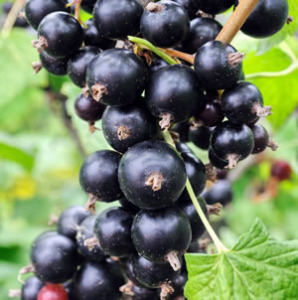Black Currant Growing Guide

What is Black Currant?
Black currant (Ribes nigrum) is a small hardy attractive deciduous shrub that fruits early Summer. Part of the Grossulariaceae family which include the other currants and gooseberry, the black currant originated in Northern Europe. The black currant canes will grow vigorously in their first year and then flower and fruit the second year. Multiple branches of these small bushes produce a multitude of flowers which are coloured pale yellow that develop into small dark purple glossy berries. Black currants commence ripening in early Summer. Grow your canes against a wall or fence, or support with a fence or trellis. Best grown in areas with a cold Winter as a ‘chilling period’ will assist fruit set. Black currants prefer a full sun position and grows best when given shelter from strong hot winds. They like rich well drained soil, however are tolerant of heavy wet soils but not water logged. Marigolds can be planted with them as companion plants.
Benefits of Growing Black Currant
Black currants have a tart taste when eaten raw so are usually used in cooking. With additional sugar the berries are used to make jams, jellies and juices. They are a fantastic natural concentrated source of vitamin C and antioxidants.
Black currants can also be used as ornamental plants due to their attractive berries and foliage.
How to Grow Black Currant
Climatic Zones
Cool, temperate, arid.
Plant Size
Height: 1m, Width: 60cm
When To Plant Black Currant
Plant in Autumn to early Winter to allow establishment before flowering in Spring.
Soil Preparation
They like a rich, well drained soil. Dig through plenty of organic matter or well broken down animal manure before planting. Spread a complete fertiliser also.
How To Plant Black Currant
Plant in full sun, 1m apart with the plant crown at soil level. Plant with roots spread out. Trim cane to 30cm after planting to prevent cane fruiting early. Plant near a support like a trellis.
Black Currant Plant Care
For optimum fruit production canes need to be kept well watered. Will benefit from mulching in Spring to conserve moisture in Summer and keep roots cool.
Black currants like to be fed. Sprinkle with general fertiliser each Spring and top dress with well broken down animal manure or compost.
In winter prune the canes that bore fruit down to the ground and tie dormant canes to the support. These will fruit the following year as black currants fruit on second year wood. Pruning is best done when the plant is dormant, but you can start pruning after the plant has finished fruiting in late Summer or early Autumn. The principle of pruning black currants is to encourage new shoots to arise from the ground. Also remove broken, weak, diseased or misdirected branches. Do not shorten new wood.
Currants are generally trouble free, however aphids and red spider mites should be watched for. Birds will be your main problem during fruiting time so you can place a net over your canes to prevent birds eating your berries.
Black currants will send out runners or “suckers”. This is just the plant trying to expand. Remove any suckers that the plant is sending out. You can either replant the sucker for a new plant or get rid of it.







